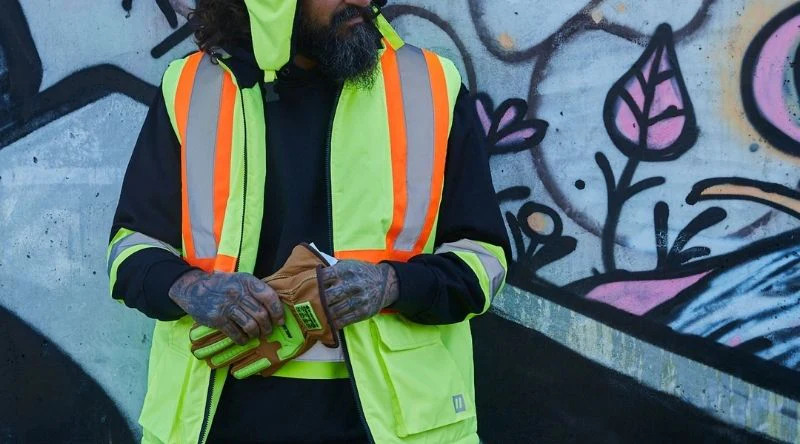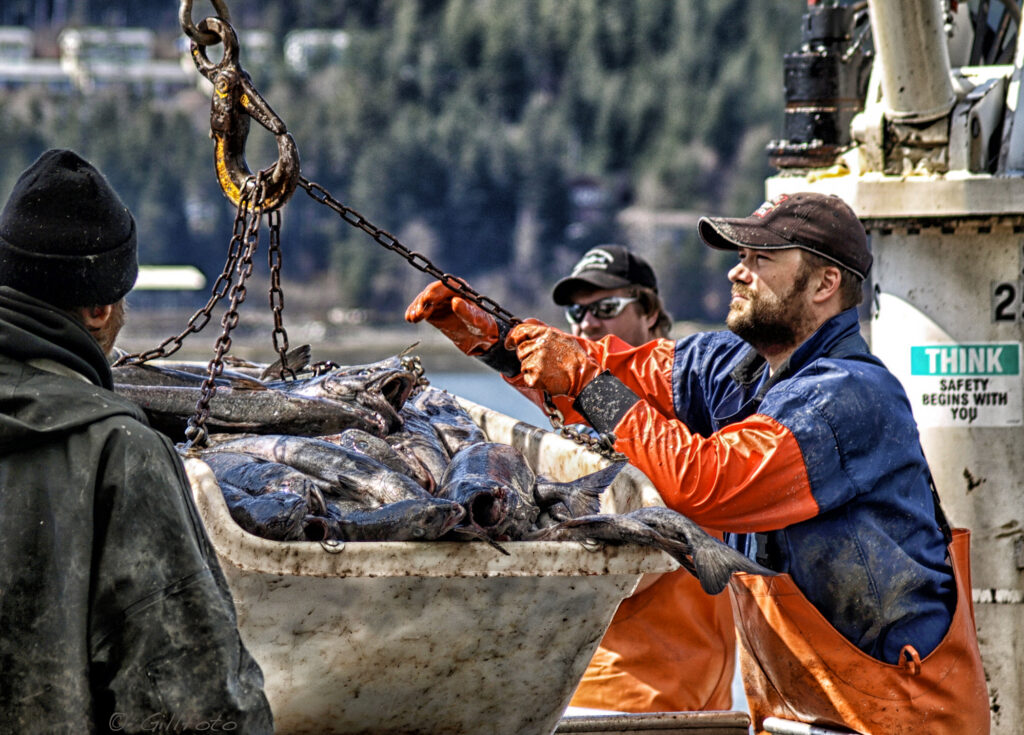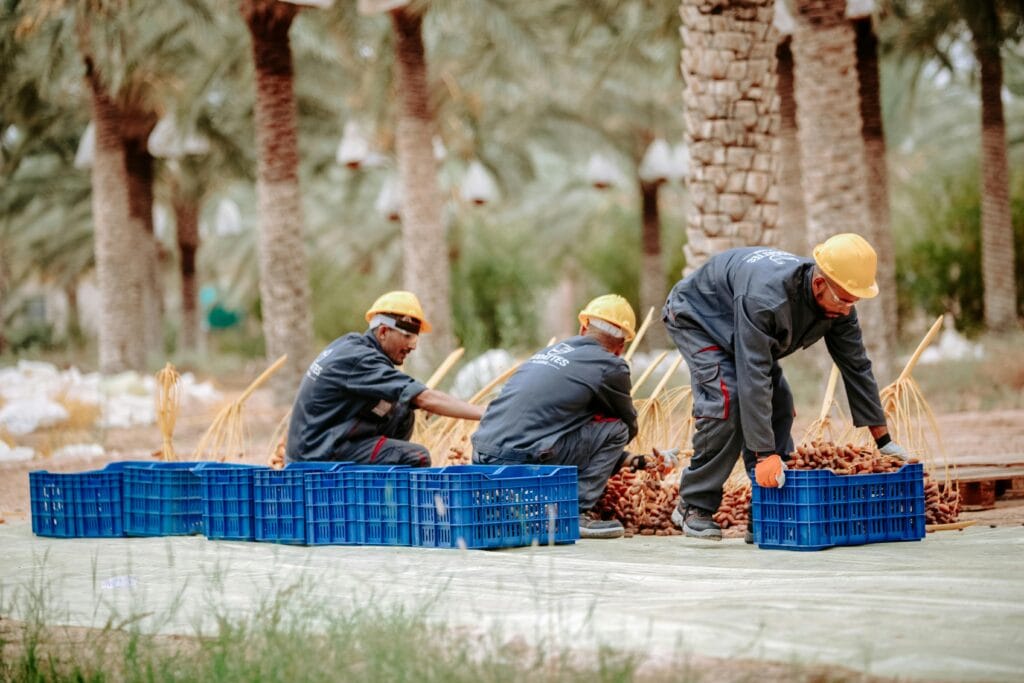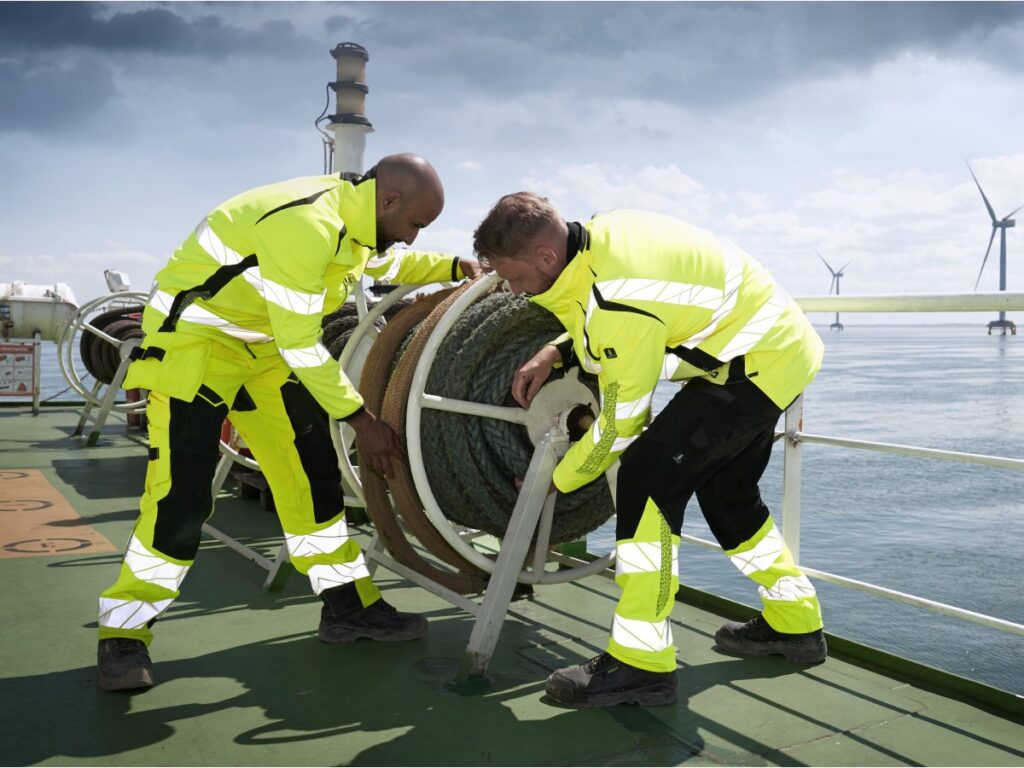
From Nairobi’s highways to Lagos’s ports and Addis Ababa’s railways, Africa is in the middle of an infrastructure boom. Workers are building roads, bridges, and power plants at a record pace. But one factor is often overlooked: worker visibility.
In environments where dust, low light, and chaotic traffic are common, the difference between life and death often comes down to whether a worker can be seen. That’s why high-visibility (hi-vis) workwear is no longer optional—it’s a core part of safety compliance and procurement strategy.
For distributors, agents, and contractors, hi-vis gear represents both a safety solution and a business opportunity. This guide explores safety drivers, standards, real-world cases, key products, sourcing pitfalls, and cost-saving strategies for hi-vis workwear in Africa.
High-visibility workwear for African infrastructure projects must meet EN ISO 20471 or ANSI/ISEA 107 standards. Key items include reflective vests, jackets, and coveralls in fluorescent yellow or orange with retroreflective tape. Buyers prioritize visibility in dusty or low-light conditions, durability for rough worksites, and affordability for large-scale projects.
Why African Infrastructure Projects Need Specialized Hi-Vis Workwear
-
Rapid expansion of construction projects
Billions of dollars are being poured into highways, power plants, and ports. Large labor forces mean higher accident risk without proper safety gear. -
Traffic and roadside hazards
Many projects involve live traffic or heavy equipment. Hi-vis clothing helps drivers spot workers early, preventing deadly collisions. -
Low-light and dusty environments
Construction often continues at night to avoid heat. Dust storms in regions like the Sahel reduce visibility, making reflective gear essential. -
International funding requirements
World Bank, AfDB, and Chinese-financed projects often require compliance with global safety standards (EN/ANSI) as part of procurement contracts. -
Reputation and repeat business
Contractors who provide proper PPE are more likely to win new projects, as safety culture is becoming a key tender evaluation point.
Real-World Cases from African Projects
Case #1 – Road Expansion in Kenya
A night-shift worker without a reflective vest was hit by a truck on the Nairobi-Mombasa highway. The incident delayed the project by 2 weeks and led to heavy penalties.
Lesson: Contractor mandated ANSI 107-compliant reflective vests for all staff, including security guards.
Case #2 – Power Plant in Nigeria
Workers received low-quality vests with reflective strips that peeled off after two washes. Visibility dropped, and inspectors flagged non-compliance.
Fix: Supplier was replaced with a certified manufacturer. Contractor now requests wash-test reports before procurement.
Case #3 – Port Expansion in Tanzania
Stevedores working in heavy dust complained that yellow hi-vis vests blended into the environment. After switching to fluorescent orange gear, visibility improved, and near-miss accidents decreased by 40%.
Case #4 – Railway Project in Ethiopia
A local distributor imported hi-vis jackets without certification labels. During an audit by an international investor, the PPE was rejected, delaying disbursement of project funds.
Lesson: Certification and labeling are as important as the product itself.
Case #5 – Bridge Construction in Ghana
Heat and humidity made workers remove their reflective jackets. Supervisors introduced lightweight mesh vests with wide reflective bands. Compliance increased, and productivity improved.
These examples highlight a simple truth: visibility saves lives. And in Africa’s infrastructure boom, distributors and contractors who supply the right hi-vis gear stand to profit while protecting workers.
High-Visibility Standards Relevant to Africa
While many African countries don’t have their own hi-vis standards yet, international benchmarks are widely enforced on projects funded by global lenders or foreign contractors.
| Standard | Region | Focus |
|---|---|---|
| EN ISO 20471 | EU | Specifies requirements for high-visibility clothing, three classes based on risk |
| ANSI/ISEA 107-2020 | USA | Hi-vis apparel for roadway & construction workers |
| RIS-3279-TOM | UK | Hi-vis clothing for railways (often referenced in African rail projects) |
| World Bank EHS Guidelines | Global | Requires hi-vis PPE on funded projects |
| AfDB Procurement Policy | Africa | Mandates compliance with international safety PPE standards |
✅ Tip for Agents: Even if local law doesn’t enforce EN or ANSI, international auditors will. Always source products with globally recognized certifications.
Key Hi-Vis Workwear Items for African Infrastructure
| Item | Primary Role | Recommended Features |
|---|---|---|
| Reflective Vests | Basic visibility for road, port, and construction workers | Lightweight mesh, 2–3 reflective bands |
| Hi-Vis Jackets | For cooler nights and rainy seasons | Waterproof, breathable, EN/ANSI certified |
| Hi-Vis Coveralls | Full-body protection in heavy machinery zones | Durable polyester/cotton blends with reflective strips |
| Hi-Vis T-Shirts | Hot weather alternative to vests | Fluorescent polyester with moisture-wicking |
| Hi-Vis Rainwear | For port and coastal projects | PVC/PU-coated fabrics with sealed seams |
| Hi-Vis Helmets & Accessories | Additional visibility in low-light | Reflective stickers, helmet bands |
📌 Field Insight: In hot African climates, buyers prefer lightweight mesh vests and T-shirts for daytime, but coveralls and jackets are in demand for night work and rainy seasons.
Material Selection Tips
Hi-vis performance depends not just on reflective strips but also on fabric type, color durability, and wash resistance.
-
Fluorescent Polyester (Knitted or Mesh)
- Pros: Vibrant colors, lightweight, dries quickly.
- Cons: Not breathable in cheap versions; fades if low quality.
-
Polyester/Cotton Blends (65/35 or 80/20)
- Pros: More durable, comfortable, less sweat build-up.
- Cons: Heavier than pure polyester mesh; requires better stitching.
-
Reflective Tape Quality
- Glass bead tape: Affordable but loses brightness after ~25 washes.
- Microprismatic tape: More expensive but retains reflectivity >50 washes.
-
Color Choice
- Yellow: Works best in urban zones but may blend with dust in rural projects.
- Orange: Stands out in dusty, desert-like environments.
- Red/Green: Sometimes used for supervisors or emergency roles.
✅ Advice for Distributors: Always test wash durability. Poor reflective tape that peels after a week destroys both safety and reputation.
Common Procurement Mistakes
-
Ignoring Certification Labels
Auditors often reject PPE without stitched labels, even if reflective strips look fine. -
Choosing the Wrong Color for Environment
Yellow vests in dusty zones become invisible; orange is more effective in such conditions. -
Overlooking Heat Stress
Thick polyester jackets cause workers to remove them. Lightweight mesh alternatives should be stocked for hot-weather compliance. -
Buying Only the Cheapest Option
Ultra-low-cost vests often fail after 2–3 washes. The “savings” disappear when replacements are needed every month. -
Not Considering Seasonal Demand
Rainwear demand spikes during wet seasons (e.g., West Africa May–July). Distributors who fail to plan ahead lose sales.
Cost-Benefit Analysis of Hi-Vis Gear
| Scenario | Without Proper Hi-Vis | With Certified Hi-Vis | Financial Impact |
|---|---|---|---|
| Roadside accident claim (worker hit by truck) | $25,000+ average claim | $4–6 per vest | Savings: $24,994 |
| Audit failure on World Bank-funded project | Loss of $3M+ tender | $0.50 higher cost per certified vest | ROI within 1 contract |
| Worker non-compliance due to heat stress | Frequent accidents | Lightweight mesh vest ($1.50 more) | Productivity ↑, accidents ↓ |
| Replacement cycle | Cheap vest lasts 1–2 washes | Certified vest lasts 25–50 washes | 20× better value |
Bottom line: In Africa’s high-volume infrastructure projects, the cost of proper hi-vis gear is negligible compared to the lives saved and contracts secured.
Layering Strategy for African Construction Sites
Unlike Europe or North America, many African worksites face extreme heat during the day and cool, damp conditions at night or during rainy seasons. A smart layering approach makes hi-vis both practical and comfortable.
-
Base Layer
- Hi-vis T-shirt or polo made from lightweight, breathable polyester.
- Helps workers stay visible without overheating in daytime shifts.
-
Mid Layer (Optional)
- Hi-vis vest with reflective bands.
- Used when supervisors or inspectors need extra visibility on site.
-
Outer Layer
- Hi-vis rain jacket or coverall.
- Essential during night work, rainy seasons, or dusty environments where visibility drops.
✅ Tip: Distributors should stock a mix of lightweight daytime gear and protective outerwear to serve both construction crews and port workers.
Risk Mitigation Strategies for Distributors & Contractors
African buyers and agents often face unique risks when sourcing hi-vis gear. Here’s how to minimize them:
-
Check Reflective Performance
Ask for retroreflective test reports (cd/lx·m² values) to confirm strips meet EN/ANSI standards. -
Demand Wash Test Reports
Cheap vests lose reflectivity after 2–3 washes. Certified products last 25+ washes. -
Audit Labeling
Ensure garments have stitched certification labels—not just printed tags that fade. -
Plan for Seasonal Logistics
Rainwear orders should be placed months ahead of rainy seasons (West Africa: May–July, East Africa: Oct–Dec). -
Trial Orders for Climate Feedback
Distribute small batches to worksites and gather worker feedback before committing to full tenders. -
Diversify Supply Sources
Relying on a single supplier increases risks of delays or fake certificates. Build at least 2–3 reliable channels in China.
Regional Distribution Tips
Different African regions have different procurement and usage habits:
-
East Africa (Kenya, Ethiopia, Tanzania)
- High demand for road construction vests.
- Orange reflective gear performs better in dusty rural projects.
-
West Africa (Nigeria, Ghana)
- Large infrastructure projects funded by oil & gas revenues.
- Demand for rainproof hi-vis jackets peaks during rainy season.
-
North Africa (Egypt, Morocco, Algeria)
- More alignment with EU standards (EN ISO 20471) due to proximity to Europe.
- Buyers are stricter on certification and labeling.
-
Southern Africa (South Africa, Zambia, Angola)
- Mining projects drive demand for hi-vis coveralls and reflective helmets.
- Buyers focus on durability as clothing faces heavy abrasion.
📌 Practical Insight: Many distributors also resell hi-vis PPE to NGOs, municipal governments, and security companies, not just construction firms. This widens sales opportunities.
Buyer FAQ
Q1: Can we use non-certified reflective vests if they “look bright”?
A: No. Without EN/ANSI certification, gear may fail audits on funded projects, leading to penalties or disqualification.
Q2: Which color is best for African projects—yellow or orange?
A: Orange is preferred in dusty and rural projects; yellow works better in urban zones with traffic. Many distributors stock both.
Q3: How long does a hi-vis vest last?
A: Certified vests last 25–50 washes. Cheap ones often fail after 2–3 washes, creating hidden replacement costs.
Q4: Do I need hi-vis rain gear for all projects?
A: Not all, but for port, coastal, and rainy season worksites, rainproof hi-vis gear is mandatory for safety and compliance.
Procurement Checklist
- [ ] EN ISO 20471 or ANSI/ISEA 107 certification confirmed
- [ ] Wash-test reports (≥25 washes durability)
- [ ] Permanent stitched certification labels
- [ ] Correct hi-vis color (yellow/orange) based on environment
- [ ] Mix of mesh vests, T-shirts, and rain jackets stocked
- [ ] Supplier audit or pre-shipment inspection completed
- [ ] Seasonal order planning for rainy periods
Conclusion
In Africa’s infrastructure boom, visibility is safety—and safety is profitability. The right hi-vis gear not only saves lives but also ensures compliance with international tenders and builds distributor credibility.
For agents and suppliers, this is more than PPE—it’s a chance to tap into one of the fastest-growing safety gear markets in the world.
📩 Need EN/ANSI-certified hi-vis workwear for African projects?
Email: [email protected]
🌐 www.workwearsolutions.net
Zion Zhang
Recent Posts
 Workwear for Latin American Fishing & Ports: Waterproofing and Corrosion Resistance2025年9月12日Fishing and port industries in Latin America are the […]
Workwear for Latin American Fishing & Ports: Waterproofing and Corrosion Resistance2025年9月12日Fishing and port industries in Latin America are the […] Workwear for South American Agriculture: Durability, Comfort, and Compliance2025年9月12日Agriculture in South America is one of the world’s largest […]
Workwear for South American Agriculture: Durability, Comfort, and Compliance2025年9月12日Agriculture in South America is one of the world’s largest […] Flame-Resistant Workwear in the Middle East Oil & Gas Industry: Safety, Standards, and Sourcing2025年9月11日In the deserts of Saudi Arabia, the offshore rigs of Qatar, […]
Flame-Resistant Workwear in the Middle East Oil & Gas Industry: Safety, Standards, and Sourcing2025年9月11日In the deserts of Saudi Arabia, the offshore rigs of Qatar, […] Workwear in Africa’s Construction Boom: Demand, Trends, and Opportunities2025年9月11日Walk through any African city today, and you’ll see […]
Workwear in Africa’s Construction Boom: Demand, Trends, and Opportunities2025年9月11日Walk through any African city today, and you’ll see […] PPE Distributor Success Stories: From Small Orders to Large Contracts2025年8月20日I’ll never forget the story of a small distributor in […]
PPE Distributor Success Stories: From Small Orders to Large Contracts2025年8月20日I’ll never forget the story of a small distributor in […] How to Build a Strong PPE Sales Channel in Emerging Markets: A Buyer’s Guide2025年8月20日I was in a meeting with a distributor from Lagos, Nigeria, […]
How to Build a Strong PPE Sales Channel in Emerging Markets: A Buyer’s Guide2025年8月20日I was in a meeting with a distributor from Lagos, Nigeria, […]
CONTACT US
- Feel free to contact us any time. We will get back to you as soon as we can!
- +86-17330061805
